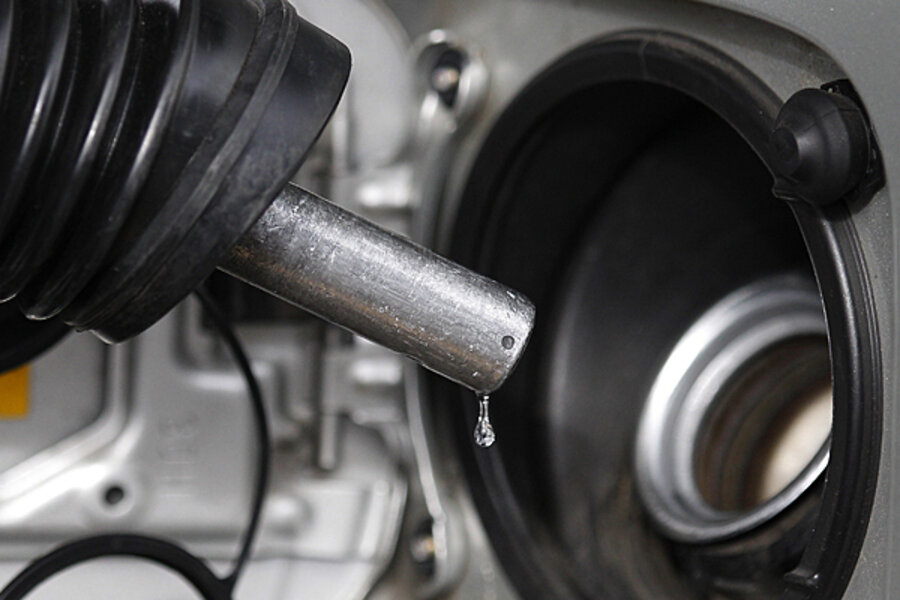Gas prices expected to soar. What gives?
Loading...
Which Oil Price to Watch?
Some economists and consumers are bracing for a sharp uptick in gasoline prices, because the price of crude oil has shot up by $10 per barrel in the last month. Except that it hasn’t, at least not if we’re talking about the global price of crude oil that’s factored into the price of the petroleum products sold in much of the US, especially along the coasts.
The global oil market, reflected in the price of UK Brent crude, is only up about $5 per barrel this month, mainly due to the situation in Egypt. A big part of the jump in domestic oil prices reflects the closing of a historically anomalous gap as US oil moves back into line with the rest of the world.
Such an increase in oil prices does not automatically herald a rise in gasoline prices, especially if it mainly erases a discount that benefited refiners in one region of the country. Moreover, gasoline and crude oil as commodities move in separate markets, linked but not in lock-step. Over the medium-to-longer term they must clearly be connected, but in the short term each responds to distinct forces of supply, demand, inventories and expectations.
After Widening for Two Years, A Crucial Gap Closes
Starting in 2011, West Texas Intermediate (WTI) crude, the main US oil benchmark, traded at an increasingly deep discount to Brent, a North Sea grade that was Europe’s main oil benchmark, and more recently the world’s. For decades, these two crudes had traded near parity, plus or minus a buck or two a barrel. Several factors changed that. The biggest was the rapid growth of production from unconventional sources in the middle third of North America: shale oil and upgraded oil sands crude. From West and South Texas to North Dakota and Alberta, Canada a wave of new oil overwhelmed existing pipeline capacity, some of which was pointed in the opposite direction to carry imported crude into the mid-continent.
The enormous tank farms at Cushing, OK began to fill up. That’s a crucial part of the story, because Cushing is the principal settlement point of the WTI futures contract. The more crude that arrived at Cushing without being needed farther north or provided an exit to the south, the higher inventories rose and the more depressed the WTI price became, relative to Brent. Nothing like that lasts forever in a highly competitive industry. At a $20/bbl discount, companies pursued every possible avenue for getting oil from Cushing to the Gulf, including building new pipelines and reversing existing ones, while using rail and even trucks in the interim. This amazing episode is nearing its end, and traders are giving up on it as an opportunity for profit.
The End of the Bottleneck Benefit for Some
What does that mean for gasoline prices? If you live on or near one of the three coasts, probably not much by itself. Consider gas prices in my home state of Virginia. Like most of the East Coast south of Delaware, the majority of our fuel is supplied by pipeline from refineries in the Gulf Coast. According to the Energy Information Administration’s (EIA) latest survey of retail prices, unleaded regular gasoline in the region sold for an average of $3.37/gal. last week. (My local prices are about 20¢ higher than that.)
If we subtract the Virginia and federal gas taxes totaling $0.375/gal., and another $0.20/gal for a typical retailer’s margin, that gets us a wholesale price of $2.82/gal. Now subtract the Colonial pipeline tariff from Houston to Fairfax, VA of $0.033/gal., leaving $2.78/gal. or $117 per barrel at the Houston-area refinery gate. Even after allowing for refinery profit margin, that suggests that product prices in the central- and lower-Atlantic states were already reflecting global oil prices, rather than deeply discounted prices for domestic crude that couldn’t find an outlet past Cushing. The West Coast was even less affected by cheap WTI.
On the surface, the return of a more normal WTI/Brent relationship poses more risk of higher prices for consumers in states where refiners have enjoyed a couple of years of less expensive crude, relative to the rest of the country. Yet EIA’s data shows that average gasoline prices from 2011-12 weren’t much cheaper in the Midwest, compared to the East Coast, than they were in 2007-10, before the crude spread widened. Cities like Tusla, OK might have enjoyed some nifty local discounts for a while, but the main beneficiaries of the crude oil bottleneck in the mid-continent seem to have been companies like HollyFrontier that were in the right place at the right time with refineries that profited much more than under more typical circumstances.
Conclusion: If You’re Worried About Gas Prices, Focus on Gasoline’s Fundamentals
Overall, in the absence of a larger shift in global oil prices, the prospect of higher US gasoline prices in the weeks ahead has more do with seasonal factors such as increased fuel demand from summer driving, and a US economy that has proved more resilient, recently, than other parts of the globe. The unwinding of an unusual gap between domestic and imported crude oil prices likely has bigger implications for domestic producers and refiners than for consumers.







